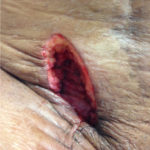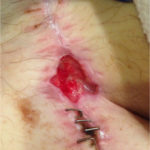
Kara Couch is a family nurse practitioner and Certified Wound Specialist, who has been working in wound care for the past 12 years. As a nurse scientist, she is an investigator on several clinical trials related to wound healing. Kara also serves as a member of the Guidelines Committee for the Association for the Advancement of Wound Care and has authored or co-authored numerous articles and chapters on wound healing. She also lectures nationally on wound care and wound healing topics.
Couch_Current Dialogues in Wound Management_2015_Volume 1_Issue 1
DEHISCED groin incisions can pose a particularly difficult wound healing challenge. These wounds occur after surgical procedures such as an inguinal hernia repair or an arterial bypass grafting procedure. If there are foreign bodies (i.e. mesh or polytetrafluoroethylene) used during the procedure, a wound dehiscence can result in disastrous outcomes, including graft/mesh infection, amputation and osteomyelitis. A systematic review of open hernia repair procedures showed a wound infection rate between 3 and 5%, with slightly higher rates for the use of mesh.1 There was a 13% incidence of femoral site graft infections after bypass procedures.
Risk factors for the development of a groin dehiscence include: diabetes mellitus, COPD, obesity, smoking, advanced age, low serum albumin, and autoimmune disease. Smoking is one risk factor that should be addressed pre-operatively if the surgery is elective. Meta-analyses and systematic reviews are clear that pre-operative smoking increases the risk of postoperative complications, including general morbidity, wound complications, general infections, pulmonary complications, neurological complications, and admission to the intensive care unit.
Once the wound dehisces, it is critical to protect the underlying vessels and/or foreign body to prevent desiccation, contamination and subsequent infection. Depending on the size of the dehiscence, the wound can be managed in very different manners.
1. Surgical debridement with possible removal of the foreign body and flap coverage.
2.Negative pressure wound therapy, to be applied intraoperatively or after dehiscence for wound management.4 (figure 1) It is important to note that V.A.C.® GranuFoam™ should not be placed in direct contact with a blood vessel or vascular anastomosis. An intervening nonadherent layer should be placed between the vessel and the GranuFoam™.
 Figure 1. Dehisced right groin wound, status post femoral bypass.
Figure 1. Dehisced right groin wound, status post femoral bypass.
3.Absorptive dressings, which can range from calcium alginates to polyurethane foams to super absorptive dressings.5
4.Anti-infectives: silver and cadexomer iodine have a role to treat any bioburden or critically colonized wounds. These can also be absorptive.
5. If autolytic or enzymatic debridement is needed for removal of fibrin from epidermolysis, topicals such as hydrogel, manuka honey or collagenase santyl can be effectively utilized.
Several factors should be considered when selecting the best topical therapy. First, evaluate the conformability of the dressing to the unique characteristics of the groin. There are typically skin folds and the issue of hip mobility that can prevent a dressing from adhering to the intact skin. Patients need to ambulate postoperatively to decrease other complications and to further their recovery; however, the movement of the inguinal area causes difficulty in keeping dressings intact. Further, in obese patients, a pannus can create an obstacle from the sheer weight of the excess tissue on the fragile incisions.
If negative pressure wound therapy is used, here are several tips to improve the seal. First, windowpane the wound with a film or hydrocolloid to allow for a taping surface that will properly seal in all crevices (figure 2). Second, the use of ostomy paste to create a “dam” in crevices is easy and can caulk any exposed surfaces. Third, if there is a large pannus present, it may require several people to place the negative pressure device so all skin folds can be held flat. In addition, when a bridge is needed, placing it to the anterior thigh as opposed to the abdomen allows for gravity to work and does not apply as much stress on the seal when the tubing is pulled.
Once the NPWT dressing is no longer needed as the wound contracts, there are numerous other topical therapies which can be used to achieve wound closure. Careful assessment of the wound bed and its characteristics, as well as the periwound, will guide the choice of dressing (figures 3-4).
 Figure 4. Superficial wound, status post bypass procedure, 1 day after initiation of honey dressing.
Figure 4. Superficial wound, status post bypass procedure, 1 day after initiation of honey dressing.
A fungal dermatitis or infection is quite common in the inguinal folds due to excessive moisture levels and the moist environment (figure 5). Application of an anti-fungal powder several times per day and meticulous nursing care can help to prevent or treat this issue.
 Figure 5. Periwound contact dermatitis and fungal overgrowth related to skin folds.
Figure 5. Periwound contact dermatitis and fungal overgrowth related to skin folds.
In summary, a dehisced groin incision can be a challenging issue for wound care clinicians and surgeons to manage effectively. The location of the wound in an area with skin folds and creases creates some technical problems with effective topical therapy. Creativity in dressing selection, careful attention to the wound environment and periwound factors progresses the wound towards complete closure.
References
1. Mavros MN, Athanasiou S, Alexiou VG, et al.. Risk factors for mesh-related infections after hernia repair surgery: a meta-analysis of cohort studies. World J Surg. 2011 Nov; 35(11): 2389-98.
2. Herrera FA, Kohanzadeh S, Nasseri Y, et al. Management of vascular graft infections with soft tissue flap coverage: improving limb salvage rates- a veterans affairs experience. Am J Surg. 2009 May; 197(5): 655-9.
3. Grønkjær M, Eliasen M, Skov-Ettrup LS, et al. Preoperative smoking status and postoperative complications: a systematic review and meta-analysis. Ann Surg. 2014; 259(1): 52.
4. Stannard JP, Gabriel A, Lehner B. Use of negative pressure therapy over closed, clean surgical incisions. Int Wound J 2012; 9 (Suppl. 1): 32–39.
5. Doughty, D. Preventing and managing surgical wound dehiscence. Adv Skin Wound Care 2005;18: 319-22.
For complete product details and safety information, please visit www.kcielabeling.com.



